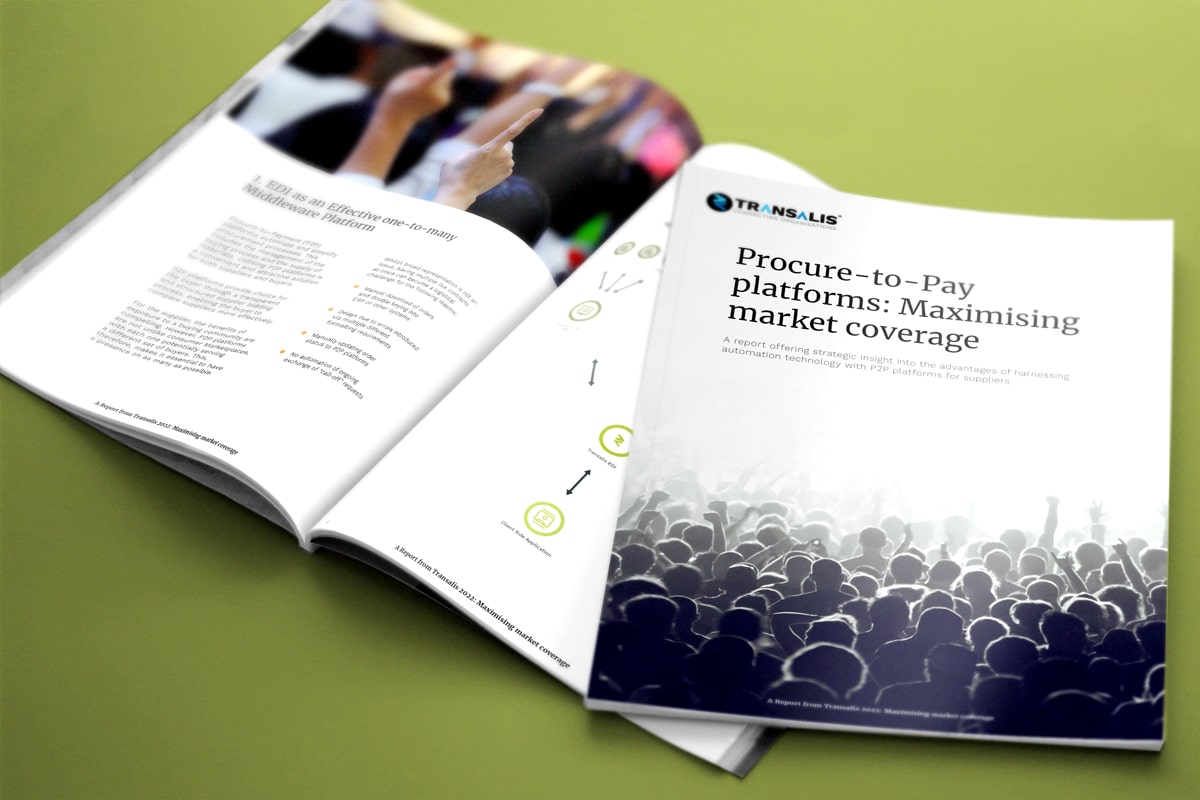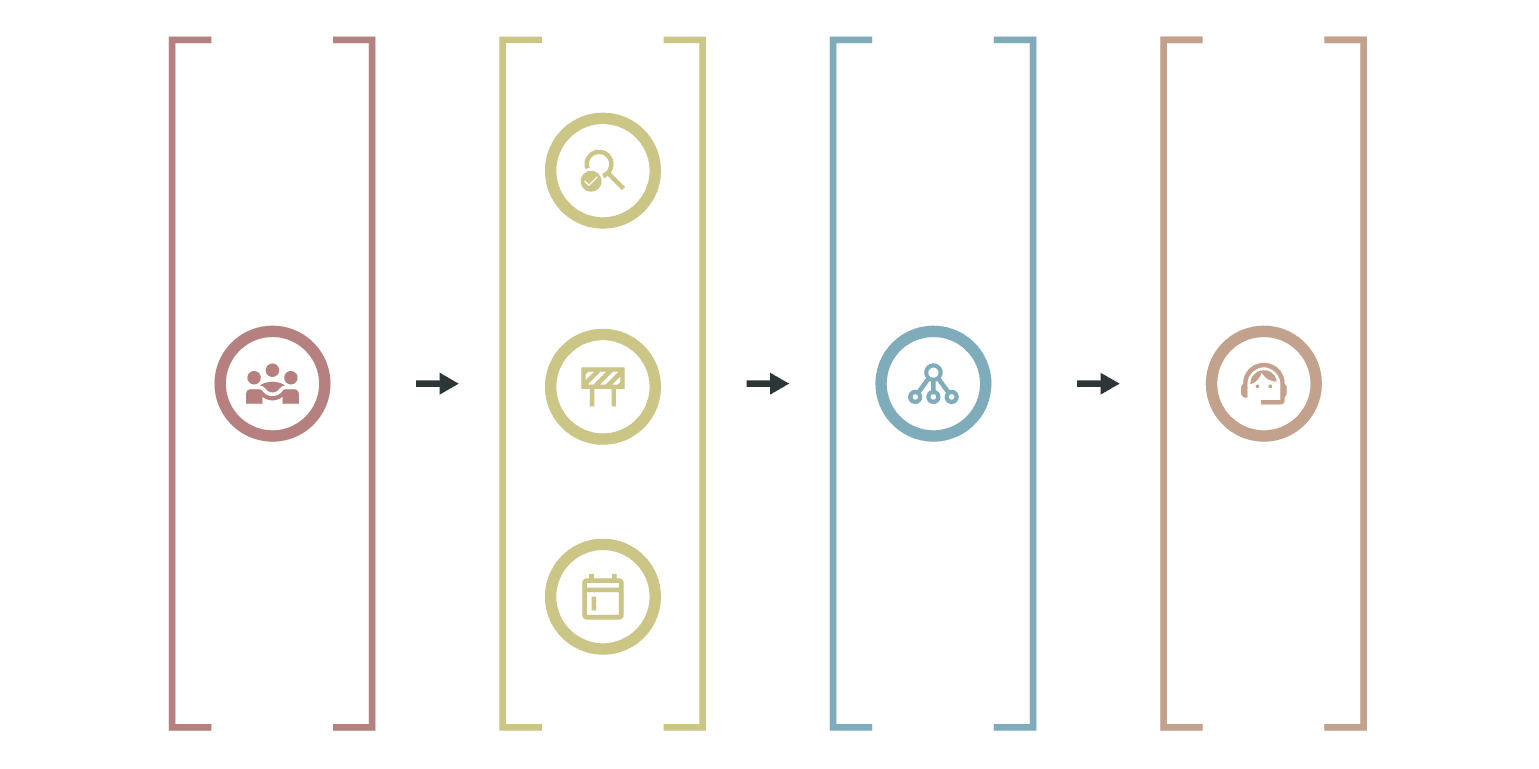
There are so many creative ways EDI can be implemented to level up an organisation’s processes, including EDI middleware.
However, upgrading existing technology and executing a suitable digital transformation strategy can be a challenge without the right guidance – perhaps you’re wondering what EDI middleware even is…
Download our whitepaper
Procure-to-Pay Platforms: Maximising Market Coverage is a report which details the benefits of P2P marketplaces as an additional sales channel for B2B suppliers

This is covered in our case study below, where we deployed the power of middleware data integration to support our client. Read more to discover the initial scope and background of the project, key business outcomes, and our recommendations for businesses facing similar issues.
Key outcomes
With our support, our client was able to achieve the following:
Automated communications between manufacturers and the client for dropship operations
Upgrade Procure-to-Pay middleware for 15 platforms and 300+ customers within 90 days
Expand client base with additional 100+ customers onboarded
Future-proof and scalable solution, with Transalis as the trusted provider for future projects
The background
At Transalis, we pride ourselves on our innovative approach to digital transformation, tackling business pain points on a case-by-case basis. With this strong industry reputation of providing tailored solutions to our customers, a client came to us with a specific set of challenges for us to solve. Following their acquisition of a majority division of an office stationary supplies brand, this organisation was struggling to manage Business As Usual (BAU) without external assistance.
Large business acquisitions can be challenging at the best of times. Especially when merging different departments and functions together. When varying technologies, applications, and processing systems are in place, it complicates things even further. As was discovered by this client.
Initially, they came to us with a specific issue related to the effective management of their dropship operation. However, we later uncovered a further challenge with the maintenance of their Procure-to-Pay platform connections, which was also critical and time-sensitive.
In this case study, we cover both of the solutions we provided to combat the issues the client was experiencing with these different sales channels. We include:
An outline of the pain points our client was experiencing
Our recommended solution and how it tackles this problem
How the solution was implemented with minimal disruption
The benefits that our client experienced as a result (in the short and long term)

The initial problem
Context
To start with, this client approached Transalis with a very specific issue related to dropship.
Although we later uncovered a greater issue with their Procure-to-Pay (P2P) platforms, we also provided an additional solution that targeted manual processing within their dropship operation.
As our client had acquired an office supplies business, they subsequently sell all manner of necessary products to B2B clients. This includes office consumables, such as stationary (pens, paper, staples etc.). For these smaller items, the client holds the stock in their own warehouses and runs a Direct-to-Consumer (D2C) operation. As the name suggests, this order process involves receiving orders for these items directly and then delivering them to the consumer. This is opposed to receiving bulk stock orders from other B2B retailers.
However, this client also supplies larger office items, such as furniture (desks, chairs, etc.). For these products, the client runs a dropship operation in partnership with third-party supplier brands. There are significant advantages to this sales strategy for many product businesses. For example, with dropship, suppliers do not need to take the financial risk of purchasing product from the manufacturer to then sell to the consumer. Suppliers with a dropshipping operation are also able to avoid the additional storage costs of holding these items in their own warehouse space.

Overall, when managed correctly, dropship can be a very lucrative sales channel. However, for this particular client, the dropship order management was not being run efficiently. In fact, they had been experiencing an ongoing issue with supplier management. This is because the existing operation relied heavily on manual processing, with the transmission and receipt of PDF documents via email. Ultimately, this operation involves manual rekeying of data on both sides of the supply chain. Evidently, this was not an efficient nor scalable way to manage these orders and it was affecting relations between our client and their dropship supplier network. Many of these 3rd party suppliers were actually pushing for EDI connections with our client in order to continue business.
Transforming manual dropship order fulfilment
So this is exactly what Transalis delivered for the client. As our Customer Service Director, Huw Davies, elaborates;
“Client enquiries around improving the processing of dropship orders has been an increasing trend for us over recent years. We have mainly attributed this to businesses, whether B2C or B2B, choosing to pivot their sales strategy during the difficult commercial period that stemmed from the COVID-19 pandemic. As a result, we have become very familiar with these types of business operations, where the inefficiencies and pain points usually lie for our clients, and ultimately, how to resolve them utilising our knowledge of process automation and supply chain technology.”
The solution we implemented for this client automatically communicated the order details with their dropship suppliers. This was achieved by harnessing EDI connections, which route the information from our client’s system directly to their trading partner’s system. Thus, removing the inefficient manual workload and also supporting these important business relationships with their dropship network.
The bigger problem
Context
Ensuring market reach is essential in an intensely competitive and uncertain business environment.
This is particularly important for B2B organisations that do not rely on typical consumer sales channels. For example, this could be because they have limited outlets to expand their customer base or brand awareness. Or perhaps they exist within a more niche business industry, therefore having a smaller market to stake a claim to.
In such circumstances, B2B suppliers have needed to get creative to ensure maximum market visibility and exposure. This can include adopting a more B2C approach with social media for example, or through the leveraging of other sales tools that are exclusive to B2B. One of these particular B2B tools is Procure-to-Pay (P2P). Purchase-to-Pay and Source-to-Pay are also widely common terms used for this group of tools (although there are some subtle differences in their function).

There’s a variety of different Procure-to-Pay platforms for B2B organisations to utilise. Each of these serves a different market; depending on the business industry. Whilst the key use-case for businesses is in automating procurement processes, they can also offer additional functionalities, such as eCommerce marketplaces.
For some, harnessing Procure-to-Pay platforms for their eCommerce functionality has been highly lucrative in securing new business. It is this very functionality that our client was utilising across a total of 15 different P2P platforms when they came to us for help.
The need for EDI middleware
Ultimately this client uncovered an extremely time-sensitive issue related to their Procure-to-Pay platform connections.
If this was not resolved in time it would result in;
Severe disruption to BAU (Business As Usual)
Significant loss of revenue
Damaged customer relationships
This issue concerned the newly acquired office supplies business division as described earlier. The utilisation of Procure-to-Pay was a key sales channel for this particular business division. The client had marketplace listings across a total of 15 different platforms, which resulted in supplying over 300 customers. To manage these connections and customer relationships effectively, the client was utilising an EDI middleware layer.
This type of integration differs from others because usually, an EDI integration relies on a one-to-one connection. However, an EDI middleware layer acts as a type of funnel which enables a one-to-many system integration. In this instance, order communications and documents being exchanged between the supplier and their customers across the different P2P platforms are all filtered through this integration middleware. Therefore, instead of having multiple individual integrations with each P2P platform, our client is able to manage these connections via one solution that automatically feeds the information into their chosen internal business system(s) and vice versa.
When the client came to us they had recently been made aware that the existing middleware they had in place was due to be withdrawn imminently. Our client was further challenged by very limited in-house knowledge of P2P processing management due to how the acquisition had played out.
Therefore, we needed to provide a suitable solution within a finite deadline. This replacement middleware had to be fit for purpose, having all existing P2P platforms (and their associated 300+ customers) onboarded within 4 months. This solution also needed to be future-proof, with the ability to adapt and scale as the client’s needs change over time.

The right approach: middleware API integration
Overall, the key objective from our perspective was to ensure that the client could maintain BAU for all customers whilst also automating all P2P messaging. Therefore, to meet this objective the solution proposed by Transalis was to leverage our knowledge of APIs (Application Programming Interfaces). Utilising APIs for this EDI middleware layer ensured this solution is robust enough to manage this type of project and would also be scalable in future.
In combination with the choice of middleware integration technology, we also needed to implement a clear onboarding strategy. During the planning phase, we harnessed our experience of onboarding excellence to manage the project in a way that allows rapid turnarounds in fulfilment for this client. With this in mind, we set out a 4 stage process that best represented our approach to onboarding, which is detailed below.
Rapid customer onboarding
Our choice of approach proved pivotal to the project’s success.

Stage 1. Recruitment: Identify the delivery team across all parties and define their roles/responsibilities
Stage 2. Engagement: Outline the plan to all parties to confirm the project scope, set timelines, and identify potential roadblocks
Stage 3. Enablement: Start onboarding following project sign-off, with multiple, simultaneous work streams
Stage 4. Handover: Transition from production/operational teams over to support and CX for ongoing management
Regarding the build of the solution, our team worked on a modular basis. Our production team were able to resource the project in an optimal way by identifying key commonalities between the P2P platforms and then replicating the configuration across them. Then they were able to dedicate appropriate time and focus to the technological exceptions.
In summary, this strategic approach in implementing EDI middleware meant that all 300 customers across the 15 P2P platforms were live within 9 weeks. Subsequently, our client was able to expand its client base and scale this area of the business. We have since onboarded an extra 100 customers, completing this in just 4 weeks.
Indicating a key vote of confidence, Transalis has been selected as the client’s ‘provider of choice’ to help facilitate all future business acquisitions. This entrusts Transalis with the management of consolidating core business systems between different divisions and brands with minimal disruption.
This project’s success is a testament to the collaboration and commitment between our teams at Transalis and with our client. Clear communication and planning from the outset are pivotal to ensuring that a project of this scale can run smoothly from initiation right through to completion. This allows for expectations to be set, resources to be appropriately allocated, and ultimately, deadlines to be met. In this case, our customer onboarding strategy was a vital element of this project. We also know that poor customer onboarding is a common concern. However, we continue to differentiate ourselves from competitors with our customer-first approach. From the outset of a project, we take time to understand our client’s requirements and deliver on our tailored recommendations.”
Transalis EDI middleware and integration software
As demonstrated in this case study, if your business requires greater connectivity, whether that’s a standard one-to-one EDI integration or a more complex one-to-many setup utilising EDI middleware integration tools, we’ve got it under control.
Consolidation of data, enhancing visibility and control, reducing overhead costs, and optimising business processes are all key benefits of business system integration. Investing in the business in this way could set an organisation apart from its competitors in the long term. Integrations remove the burden and reliance on personnel to re-key and manage crucial business data. As opposed to in-office teams, integrations can run on a 24/7 basis. This results in significant ROI over manual processes as well as allowing room for the business to grow and evolve.
The outcomes described in the case study above speak for themselves.
eDI Software
Choose from our wide variety of different systems integrations, including P2P EDI middleware, on our dedicated page. Alternatively, if you would like some more guidance, you can talk to our dedicated team: 0845 123 3746 (calling from UK), +44 1978 369 343 (for international callers), or email sales@transalis.com. You can also visit our Knowledge Hub to explore our other useful resources, including other client case studies, whitepaper reports, and blog articles.











